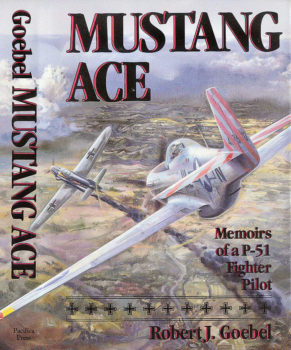 Gary Goebel
Gary Goebel
Mustang Ace
My father began writing his World War II memoirs in the late ’80s and, after a very rough beginning and with the assistance of several noted military writers, crafted a very engaging book. Summaries of it are available from different sources and are condensed as follows:
Bob Goebel and his friends and peers arrived on the WWII front at the same time as the P-51 Mustang and the result became Aviation history. The P-51 had the range and firepower to sweep deep into Axis territory from both England and the Italian fronts, protecting the heavy bombers and forever changing the complexion of the air war. The audio book cover art, derived from a painting by Lonnie Ortega, illustrates the fourth victory by Bob Goebel in a P-51B and can be compared to the Hard Book cover art by David Horwarth with Bob’s 11th victory, but now in a P-51D. The bubble canopy and added firepower of six instead of four guns shows the evolution of the P-51 fighter, the entire book describes the evolution of a US Army Air Corps fighter pilot.
When Bob left home to join the Army Air Corps in 1942, he was nineteen years old and a high school graduate. Cadet Goebel worked his way steadily through the Basic, Primary and Advanced phases of military flight training and found in himself an aptitude for flight. Bob himself observed that at every phase of flight, a different group of individuals emerged as leaders and this held true into Squadron operations and eventually combat as well. After graduation from flight school with his new wings and a new commission as a 2d Lieutenant, he and some of his classmates were posted to a fighter squadron defending the Panama Canal. By the spring of 1944 he was on his way to Italy and the 31st Fighter Group, which rose to become one of the top fighter outfits of the war. After a short time in Spitfires, he was also headed for a new aircraft, the legendary P-51 Mustang. After 61 combat missions, now Captain Goebel, was officially credited with 11 aircraft destroyed and one probable in his Mustang. Returning home in September 1944 he was not yet 22 years old. Goebel’s memoir is a classic of combat aviation; it covers stories about the often overlooked 12th AF in Italy and tales of flying the classic P-51D, America’s ultimate piston engine fighter.
Fighter pilots are generally considered the elite of the pilot fraternity, at least by themselves. There were approximately 150,000 fighter pilots in all services in WWII, but only about 1350 tallied the five aerial victories and became an “Ace,” less than one percent. This book can be read or listened to simply as an entertaining and true adventure story, but it is also a well written, well researched and very engaging personal account of WWII aviation history. There will never be a more accurate account of this phase of the air war; most of those who actually experienced these events have now gone to their final reward. Goebel’s memoir is a classic of combat aviation, giving the listener a true sense of what it was like to fly and fight as a World War II fighter pilot.
Following the war, Robert J. Goebel attended college on the GI Bill, earning a degree in physics from the University of Wisconsin. Returning to the air force, he served on active duty for almost 30 years, retiring as a lieutenant colonel in 1966 after working on the Gemini launch vehicle for NASA. He then worked in the aerospace industry, including on the Skylab project. The author died in February 2012 just days short of his 88th birthday. He was preceded into the unknown, in 2006, by his wife, June.
Mustang Ace is available on Amazon in several different formats: the original hardback book, a softback book, an ebook and an audio book. The ebook is inexpensive but does not have the photographs of the physical books; the audio book is a recent addition. Part 2 of this article will give a couple of representative comments from the 50+ available on Amazon and describe the marking of the audio book.
